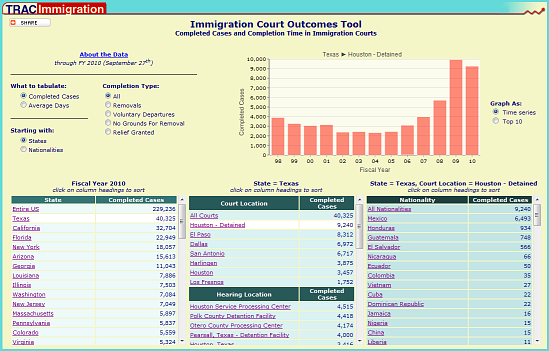During the past year, Immigration Courts took 20 percent longer to act on cases before them than they did the previous year, according to very timely government enforcement data obtained by the Transactional Records Access Clearinghouse (TRAC). The average number of days it took to dispose of cases decided during FY 2010 was 280 days, 47 days longer on average than completion times for FY 2009 (see Table 1).
Table 1. Immigration Courts Take Longer to Act on Cases
|
|||||||||||||||||||||||||||||||||||||||
Not surprisingly, it took the longest time to complete those cases in which the court granted some form of relief. Completion times for relief cases took an average of 696 days, or roughly 23 months this past year. These times were 39 days longer than the average time spent in FY 2009. Cases in which the presiding judge issued a removal order took the shortest amount of time — an average of 140 days. This was still 17 percent longer than the time similar cases took in 2009. Voluntary departures orders took an average of 323 days, an increase of only 3 days over times during FY 2009.
All figures are based upon TRAC's analysis of case-by-case data it obtained under the Freedom of Information Act (FOIA) from the Executive Office for Immigration Review (EOIR) and cover the period through September 27, 2010.
| |
TRAC has previously reported on the growing backlog of cases in Immigration Courts waiting to be acted upon. However, backlog wait times only tell how long people have already waited in the queue. They tell us nothing about how much longer individuals may need to wait before their cases are actually resolved.
This report is the first in a new series to provide definitive numbers on how long judges actually take before they rule on a case. As we see in Table 1, cases where judges terminated a case because they found the government had not shown grounds for issuing a removal order took on average three times longer to resolve in FY 2010 than cases where a judge agreed with the government's case and issued a removal order. Voluntary departure decisions took an average of more than twice as long as when removal orders were granted, while grants of relief took five times longer than removal orders.
This month (November 2010) EOIR announced the hiring of 23 new immigration judges. TRAC will be monitoring how these additions impact both backlog and completion times in future updates to our reports.
Accompanying this new TRAC report series on outcomes, TRAC has developed a new user "Outcomes" application. Parallel in design to TRAC's popular Backlog app, the Outcomes app provides comparable numbers on decided cases, including average decision times, for each state, EOIR court, and hearing location. Separate figures are compiled for each nationality. The Outcomes app lets you display trends over time on either the volume of cases decided or the length of time decisions took. Click on the image below to try out TRAC's Immigration Court Outcomes App.
Selected Highlights
Disposition Times by State
Compared to the national averages, Immigration Courts in California took the longest time to resolve — 526 days in FY 2010. At the other extreme was Louisiana which took an average of only 56 days to decide a case. Table 2 presents states with the longest as well as shortest decisions times last year for different types of outcomes. Oregon courts (which also cover Idaho, Montana and Alaska) were the slowest at issuing removal orders. They took an average of 446 days as compared with Louisiana with 32 days.
Last year the state with the shortest average times for granting relief was Nevada with 398 days. The state taking the longest times on average to grant relief was Nebraska at 961 days.
Table 2. Disposition Times by State
|
|||||||||||||||||||||||||||||||||||||||
Disposition Times by Nationality
When court outcomes are examined for individual nationality groups, individuals from Armenia had the longest completion times in three out of five categories. Overall, their cases took on average 1,152 days to resolve. During FY 2010, the shortest decision times occurred for individuals from Mexico where cases were resolved in an average of 146 days, and removal orders were issued on average within 58 days. See the table below for other countries that topped the list for the longest and the shortest Immigration Court disposition times. Full details for every nationality can be obtained by using TRAC's new "Outcome" Tool.
* Nationalities with fewer than 100 cases excluded from rankings.
Table 3. Disposition Times by Nationality
|
|||||||||||||||||||||||||||||||||||||||
Changes in Volume of Cases Decided
Results were also compared on the volume of cases immigration judges decided. The Charlotte court saw the largest increase between FY 2009 and FY 2010 — up a whopping 40.3 percent. The Harlingen court saw the largest decline; its dispositions were down 41.8 percent in FY 2010 as compared with the previous year. As shown in the table below, the Los Angeles, Memphis, Kansas City and Dallas courts all increased the volume of case completions last year. The courts based in San Diego, Eloy, Florence and Tacoma all registered substantial declines.
Table 4. Volume of Cases Decided
|
||||||||||||||||||||||||||||||||||||||
Changes in Length of Decision Times
Most courts across the nation took longer on average to complete cases last year. The Oakdale Immigration Court took almost twice as long (96% longer) during FY 2010 as compared with FY 2009. The other courts that had the largest increase in decision times were the Tacoma, Guaynabo, Lancaster, and San Diego courts. For details see table below. At the other extreme, the Omaha court was able to complete cases last year slightly more quickly, registering a 15 percent decline in the average decision times. As shown in the table below the courts based in San Francisco, Las Vegas, Orlando, and Harford also all registered small declines in their average completion times.
Table 5. Length of Decision Times
|
||||||||||||||||||||||||||||||||||||||
